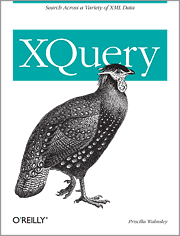Description
The functx:sequence-node-equal function returns a boolean value indicating whether the two arguments have the same nodes, in the same order. They are compared based on node identity, not their contents.
Arguments and Return Type| Name | Type | Description |
|---|
$seq1 |
node()* |
the first sequence of nodes |
$seq2 |
node()* |
the second sequence of nodes |
| return value |
xs:boolean |
XSLT Function Declaration| See XQuery definition. | <xsl:function name="functx:sequence-node-equal" as="xs:boolean"
xmlns:functx="http://www.functx.com">
<xsl:param name="seq1" as="node()*"/>
<xsl:param name="seq2" as="node()*"/>
<xsl:sequence select="
every $i in 1 to max((count($seq1),count($seq2)))
satisfies $seq1[$i] is $seq2[$i]
"/>
</xsl:function>
|
Examples<xsl:variable name="in-xml" as="item()*"> | | <authors>
<author>
<fName>Kate</fName>
<lName>Jones</lName>
</author>
<author>
<fName>John</fName>
<lName>Doe</lName>
</author>
</authors> |
| </xsl:variable> | <xsl:variable name="anAuthor" as="item()*"> | | <author>
<fName>Kate</fName>
<lName>Jones</lName>
</author> |
| </xsl:variable> |
| XPath Example | Results | Explanation |
|---|
functx:sequence-node-equal(
$in-xml/author/*, $in-xml/*/*) |
true |
functx:sequence-node-equal(
$in-xml/author,
($in-xml/author[2],$in-xml/author[1])) |
false |
The order of the nodes is different. |
functx:sequence-node-equal(
$in-xml/author[1],$anAuthor) |
false |
Although the nodes have the same content, they are not the same node. |
See AlsoHistory |
Recommended Reading: 
|

